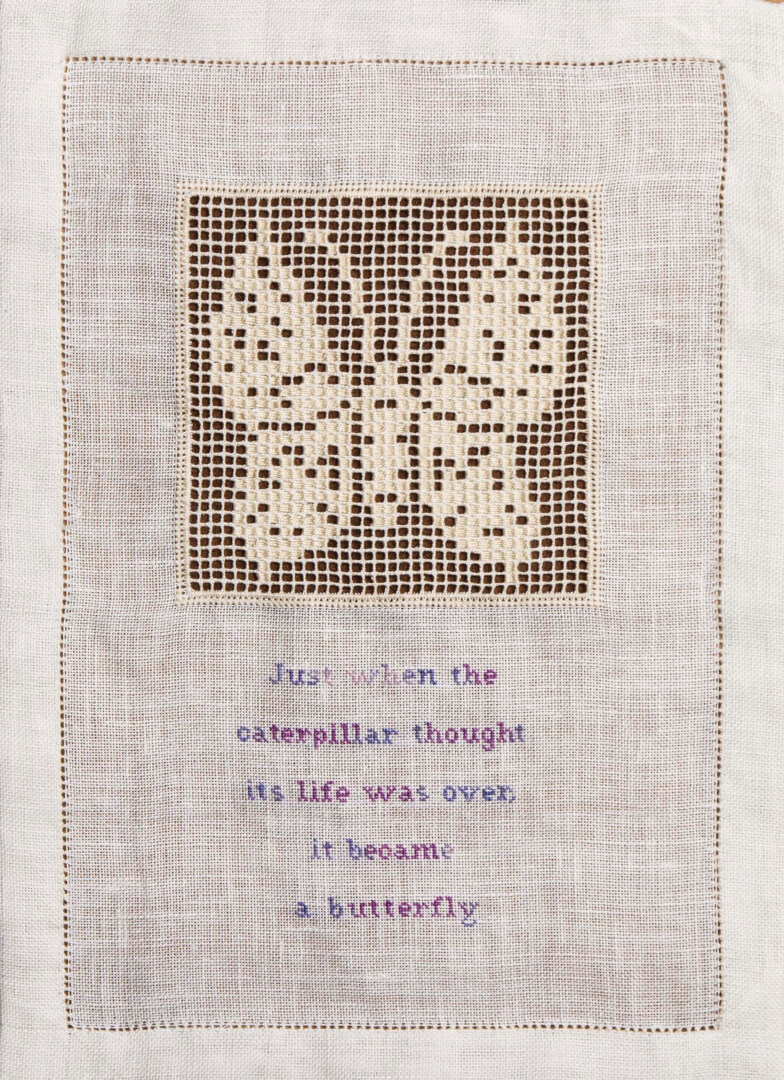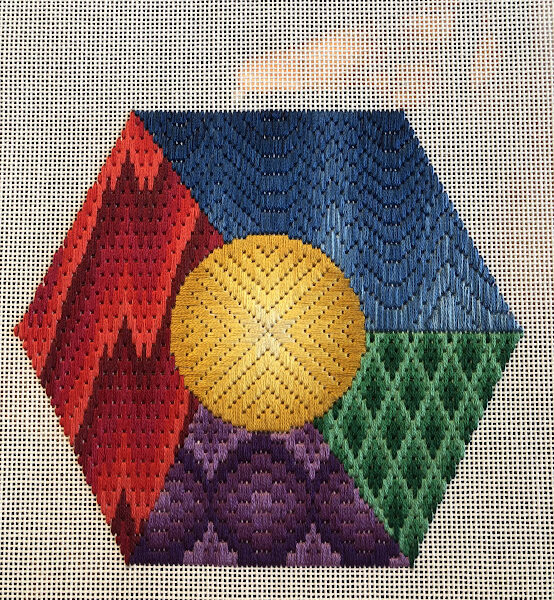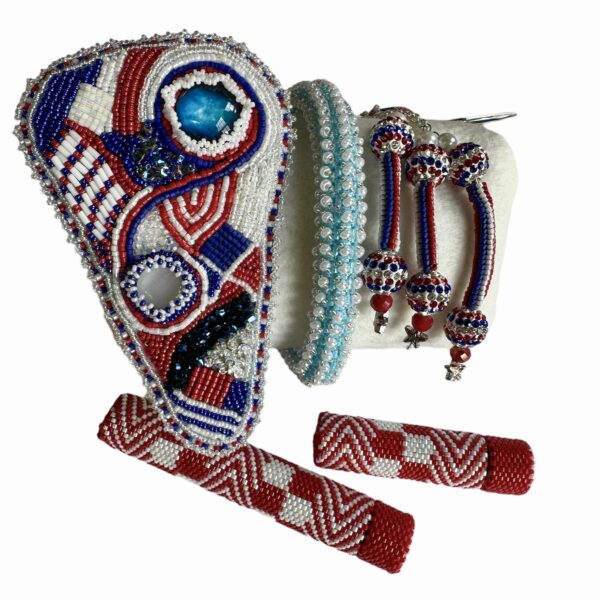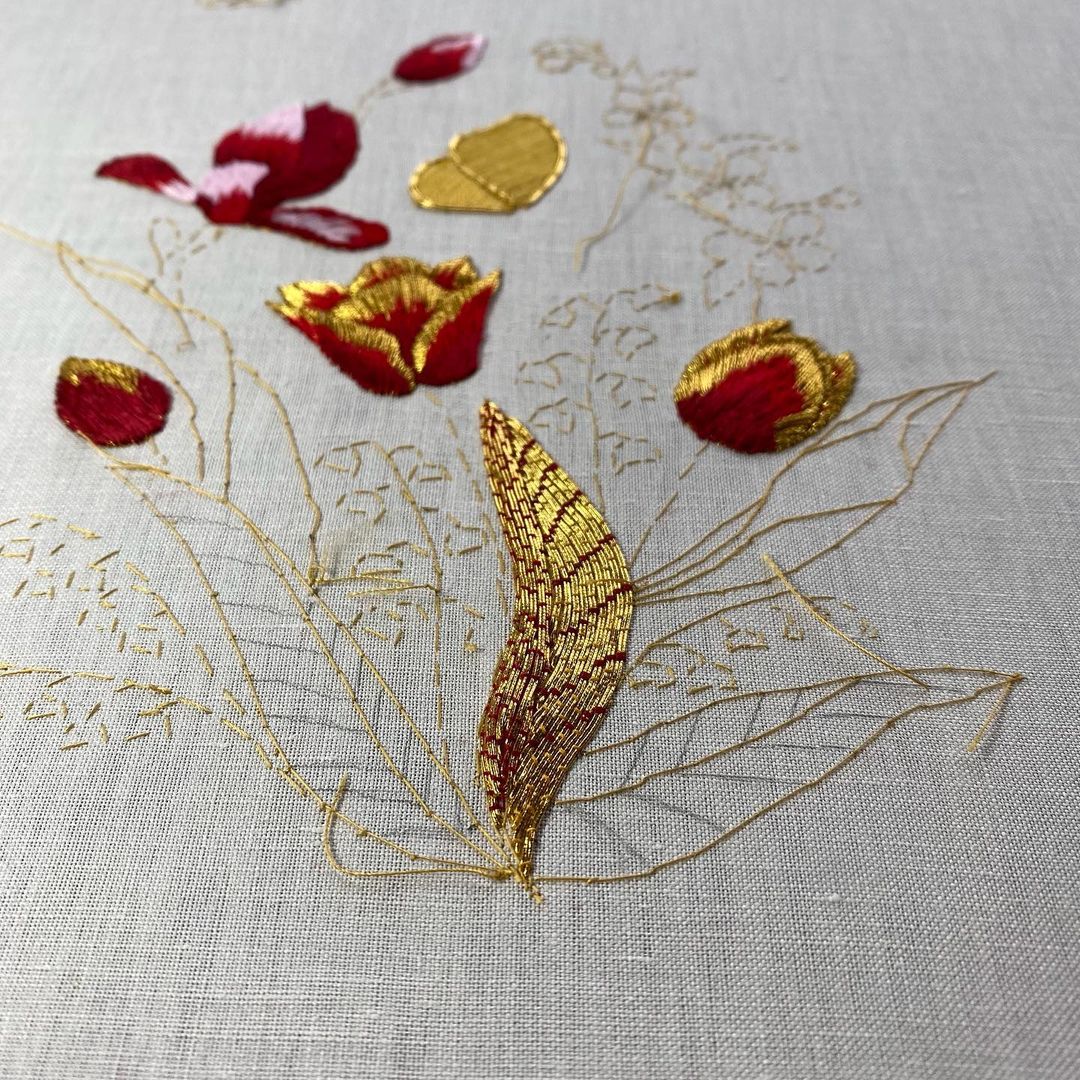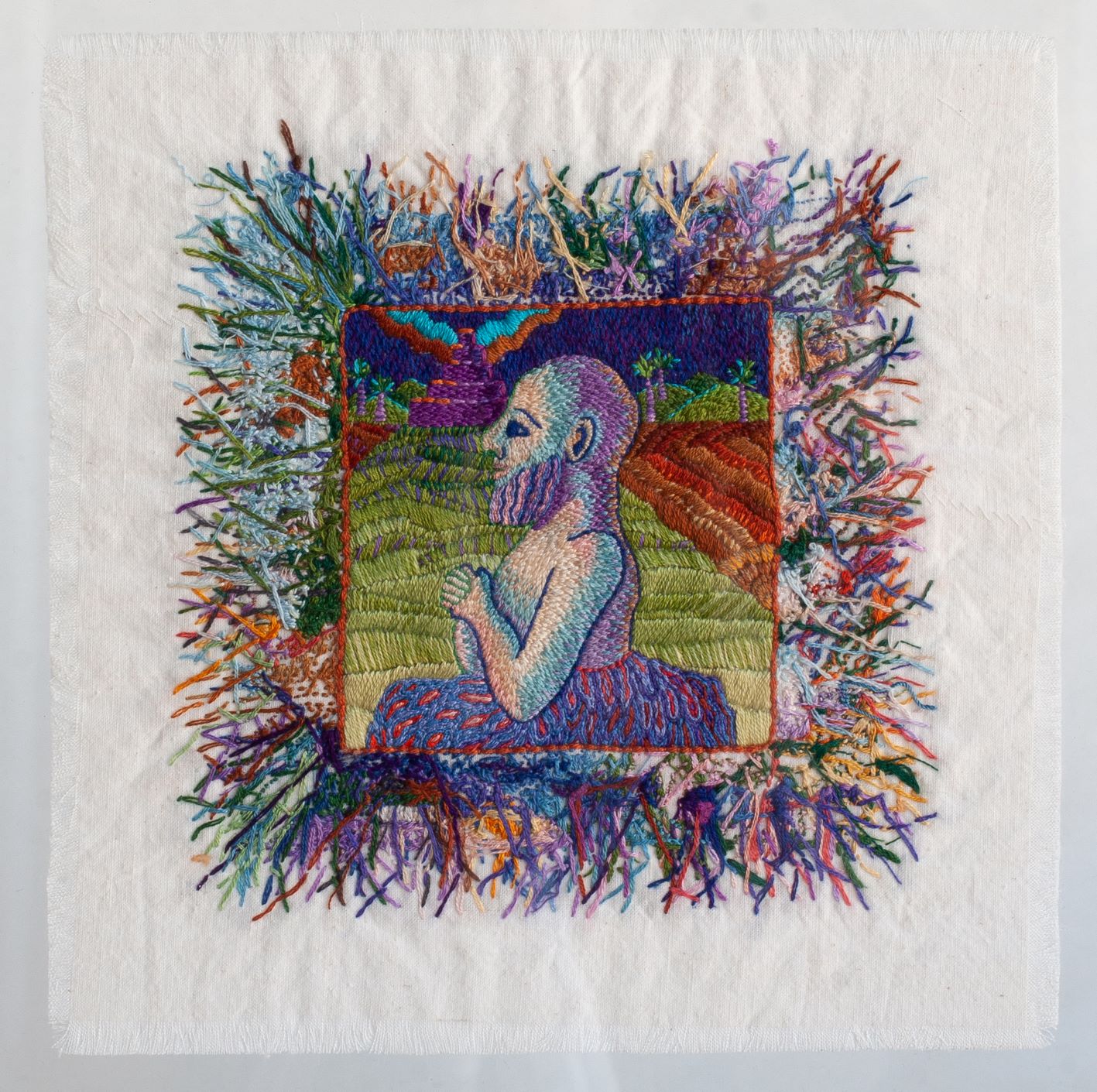Designer & Teacher Melinda Sherbring
This is an excerpt of a profile that originally appeared in the March 2018 issue of Needle Arts magazine.

A medieval-style wedding at the World Science Fiction Convention in Los Angeles, California, sparked Melinda Sherbring’s interest in recreating the world of centuries past. She joined The Society of Creative Anachronism (SCA) in 1972 while she was still in college. “SCA is based on the ideals of honor and chivalry,” she stated. “We seek to emulate the high middle ages by hosting tournaments and feasts, promoting the arts of the period, and wearing appropriate clothing.”
After earning a Bachelor of Science in math and a Master of Science in computer science and electrical engineering, Sherbring moved from New Mexico to southern California in 1975. On weekdays she programmed cutting-edge aerospace projects for a defense contractor. One project translated a data stream from Landsat satellites into detailed photographs of Earth, providing tools for analysts to enhance the pictures. On weekends, she sought an earlier time in history, learning and applying historical crafts in the active SCA community in southern California.
Like EGA, the SCA encourages excellence in an art form, but it does not instruct it. People within the SCA encourage members to consult primary sources and advise ways to conduct research in an area of interest. The people, not the organization, are the ones that dig into history and share their finds.
To add to the fun, each member creates a persona who lives before 1600 and comes from western Europe or places that interacted with western Europe. Sherbring said, “People are encouraged to choose a time and place that they wish to learn about. Some people dive very deeply, others not so much.” Sherbring’s persona is Éowyn (A-oh-win) Amberdrake, named after a female warrior in J. R. R. Tolkien’s Lord of the Rings. Sherbring explained, “At the time I chose the name, I had been in university fencing clubs for several years, so I wanted to take the name of a female fighter.” Amberdrake means “yellow dragon,” further underscoring the character’s fierceness.
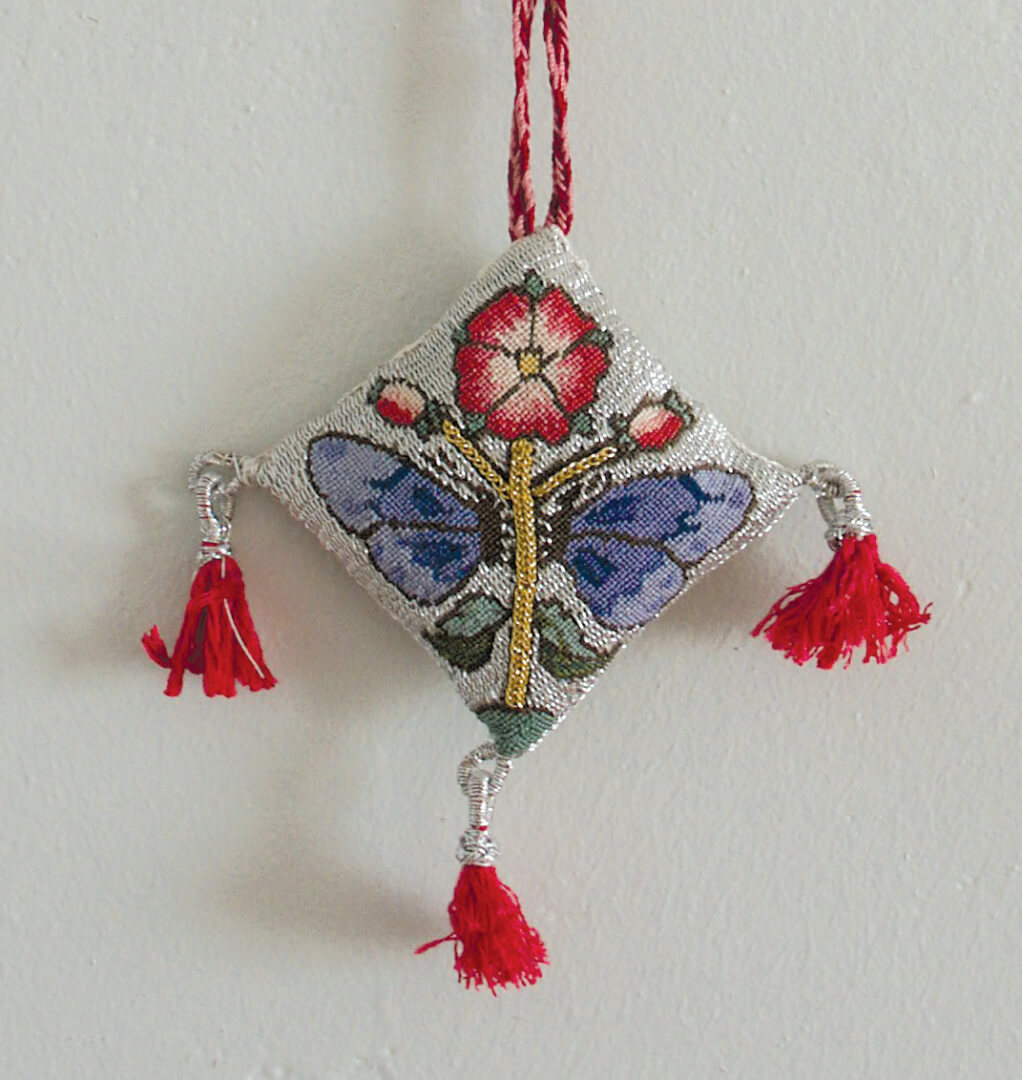
Sherbring doesn’t always portray her persona in Tolkien attire, however. She seeks variety. “Sometimes I dress as the seventh- to eighth-century Anglo-Saxon lady that Éowyn would have been,” she said. “Other times I dress as
a ninth-century Viking, an eleventh-century Norman, a fourteenth-century Englishwoman, a fifteenth-century Italian, an Ottoman Turk, or an Elizabethan.”
While personae are not actual historical figures, what they do and wear are from the period they represent. Given her interest in illuminated manuscripts, Sherbring decided that Amberdrake would be a scribe. “When I was about six years old, my dad brought home some pheasants for dinner, and when I asked what we could do with the beautiful feathers, he mentioned that people once used feathers to write with,” Sherbring remembered. “In the SCA, I found people who showed me how to write with feathers and how to accomplish other scribal arts. Scribes have an important role within the SCA to print and illustrate award scrolls. So, I learned from others, and eventually became head of the College of Scribes in my region.”
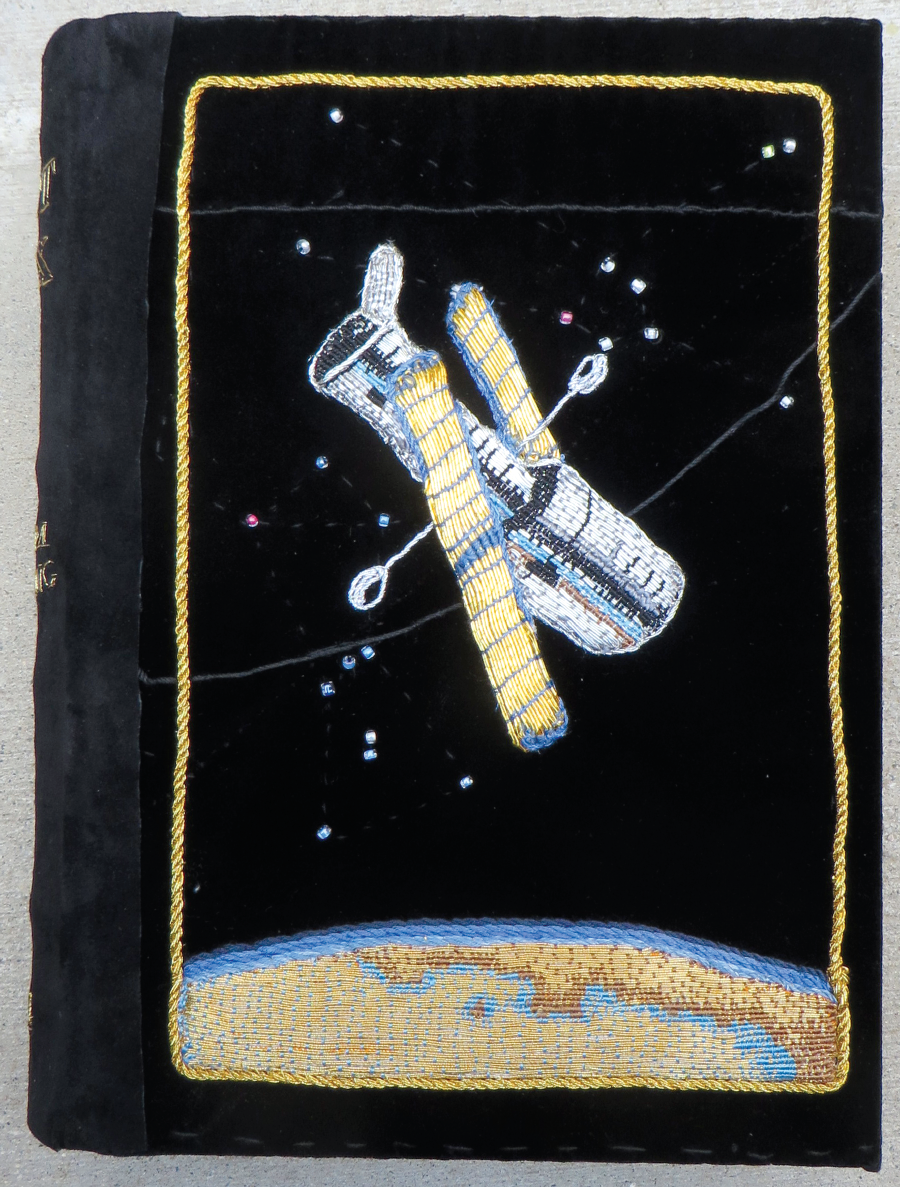
In 1984, Sherbring joined the national board of directors for the SCA. This position led her into needlework. “The board meetings were long,” she observed, “and I noticed others were embroidering during segments of the meetings that did not pertain to what they were involved in. A friend introduced me to counted cross stitch as something I could do while listening at the meetings.”
During that time at work, Sherbring led a team working on the ground station for the Hubble Space Telescope (HST). The Challenger disaster in 1986 delayed the HST launch for several years. She commemorated her work on the project in an embroidered book cover for an EGA Challenge with a Twist. The title of the book cover, Fiat Lux means “Let there be light.” She stitched the Hubble Telescope, the focus of her design, in padded or nué. The area of Earth represented is southern California, where she lives. Catalina Island is visible. She used black velvet to depict space and Mill Hill beads form the stars in the constellation, Taurus, her birth sign. She added the constellation Orion, with Bellatrix, Rigel, and other colorful stars. (Continue reading below)
In 1988, Sherbring had an opportunity to join the performance troupe of re-enactors Past Times with Good Company. Twenty-one performers traveled to England and Scotland to help celebrate the four hundredth anniversary of the defeat of the Spanish Armada. Costumed as though it were 1588, they performed English Country dances, songs of the era, and demonstrated crafts, such as embroidery and calligraphy, in a variety of historical venues, all of them speaking with British accents. She said, “We were a bit of a novelty. This was before costumed historical interpreters were as common in Britain as they are now.”

Sherbring joined EGA when a chapter with evening meetings formed near her home in the early 1990s. She took many classes and enrolled in EGA’s Master Craftsman Program in counted thread in the mid-1990s. Many of her embroideries reflect the inspiration she receives from the SCA. S is for Scribe was her Step 2 design. She said of the piece, “Romanesque manuscripts often feature birds and animals shaped like letters. The vines weaving through the background may show people doing things. I added monk scribes around the first letter of my last name which is in the shape of a dragon, my totem animal.”
The pieces for Step 3 were inspired by the 1988 trip to England. Sellinger’s Round and Hearts Ease depict troupe members dancing. Sherbring used blackwork patterns and varying weights of thread to shade and highlight areas of the design. For further definition, the woman’s attire in Sellinger’s Round is fashioned in circles and curves while the gentleman’s clothing sports more linear stitches.
A true scholar, Sherbring stitched a Sampler of Threads in 1996 to take along on visits to museums. She stitched the same pattern in a variety of threads and labeled the patterns with the name or type of thread stitched. It is a clever way to compare and identify thread weights in collection pieces.
One of her more intriguing embroidery projects was conceived and stitched for an EGA Competing Needles event in 1999. Sherbring received a second place for A Blackwork Anthology, a sampler of various blackwork techniques each worked on a small piece of fabric. These examples were later collated as pages in a book. Each page features an Elizabethan flower in blackwork and is finished with a hem on all edges. In addition to the page with the stitched flower, each unit includes a page with sixteenth-century poetry or quotations referring to the flower; a page on the design, style, and historic techniques; and a page with the materials and techniques worked in the flower. She has continued to add pages; by 2015, the book documented fourteen flowers in different blackwork variations. Sherbring plans to publish it.
 Sherbring’s playfulness is apparent in Giraffe Rules: Ways to Play with Blackwork Today. The spots on the giraffe’s neck are filled with variations of the same filling, one based on a filling on a seventeenth-century nightcap at the Los Angeles County Museum of Art (LACMA). The stiff hairs along the spine are straight stitches. Adding a bit of humor, she stitched a twelve-inch ruler along the right border to draw attention to the elegant length of the giraffe’s neck.
Sherbring’s playfulness is apparent in Giraffe Rules: Ways to Play with Blackwork Today. The spots on the giraffe’s neck are filled with variations of the same filling, one based on a filling on a seventeenth-century nightcap at the Los Angeles County Museum of Art (LACMA). The stiff hairs along the spine are straight stitches. Adding a bit of humor, she stitched a twelve-inch ruler along the right border to draw attention to the elegant length of the giraffe’s neck.
The intriguing designs of Opus Anglicanum, a golden age of embroidery, sometimes included mythical creatures such as the wyvern, a two-legged, winged dragon with a reptile’s tail. Sherbring used the wyvern in The Dancing Dragon (see page 1, the table of contents), which she entered in an SCA challenge. Influenced by the Old English epic, Beowulf, Sherbring’s wyvern dances on his hoard of gold and weapons. “His head looks more like my half-Pekingese dog, than the typical lion’s head,” Sherbring comments. “He is holding a spear to reflect the incident when a spear hit me, leaving a crease in my skull. The weapon’s maker, Ben Abbott from the Forged in Fire television program, gave the spear to me, and I have named it Noggin–Knocker.” She added Éowyn’s arms to the shield and fitted flying doves and hawks into the corners. The embroidery is worked in split stitch, underside couching, and tramé.
Sherbring was involved with SCA’s College of Arms for several decades and has written some forty articles over the years, including one about the heraldry on an embroidered chasuble in the LACMA collection.
She stitched Amberdrake Arms, Baroness Éowyn’s heraldic patch in 2011 using plaited braid stitch as analyzed by Leon Conrad and published in a series of articles in the summer and fall 2003 Fine Lines. Using Elizabethan stitches of silver and gold metallic thread on blue silk and pearls for eyes, the dragons come to life. Marcus Arms was finished the following year for her husband’s SCA persona, Sir Jamal Damien Marcus. She worked the Tree of Lebanon in purl wrapped in colored silk on white dupioni and the eagle in pearl purl, paillettes, and gold passing thread on blue dupioni.
In 2010, she designed the sampler Elizabethan Lozenges. She explained, “I worked the first version in metallic threads. When I filled in the background, it looked wrong to me. I realized Elizabethan embroidery didn’t have large expanses of background; everything was crowded together.” (Continue reading below)

Extended Study Program: Uncommon Stitches
Join us and designer Melinda Sherbring in California for an embroidery
adventure exploring stitches rarely used in the modern world.
She began again in 2011, adding silk threads and wider bars. As she studied historical pieces, she found and recreated three stitches that were not covered in any of the books she had read. She named them offset cross, plaited braid with a twist, and woven open chain. In 2013 she added flowers to the lozenges. She noted, “There are thirty linear stitches, eight silver backgrounds, eight knots, and five stitches in silk. The names of some of the metal-thread stitches have not survived to modern day.”
Sherbring loves everything related to sweet bags. She has been researching Elizabethan embroidery since 1999 and has located more than two hundred sweet bags. She has been able to study fifty in museums. When she began her research, she read in many books that the coiling stems were worked in plaited braid. “As I had studied coifs, gentlemen’s nightcaps, and ladies’ jackets, I could see that other stitches were used as well,” she reported. “I enlarged photos to the point that I could trace the stitch path, and then I charted them.”
A small variation on sweet bags is her Nametag Bag in blackwork, which she finished in 2003. It has all the components of a sweet bag—tassels, cording, floral design—but it is only 3˝ x 3¼˝. She stitched her name below the drawstring at the top of the nametag. The neck strap is fingerloop braided cord.
Later she created Blue Butterfly Sweet Bag. The background is fully stitched in encroaching gobelin on one side and plaited gobelin on the other. She worked the flowers and fruit in petit point. The drawstring is a fingerloop braid that required three people to braid. The braiding pattern, “A Purse String with Silver in the Middle,” is from the British Library Additional manuscript 6293. To personalize the bag, she added an El Segundo Blue Butterfly in honor of her EGA chapter.
Sometimes sweet bags are accompanied by pin pillows. She designed Butterflies and Roses as a companion to the sweet bag. (Continue reading below)
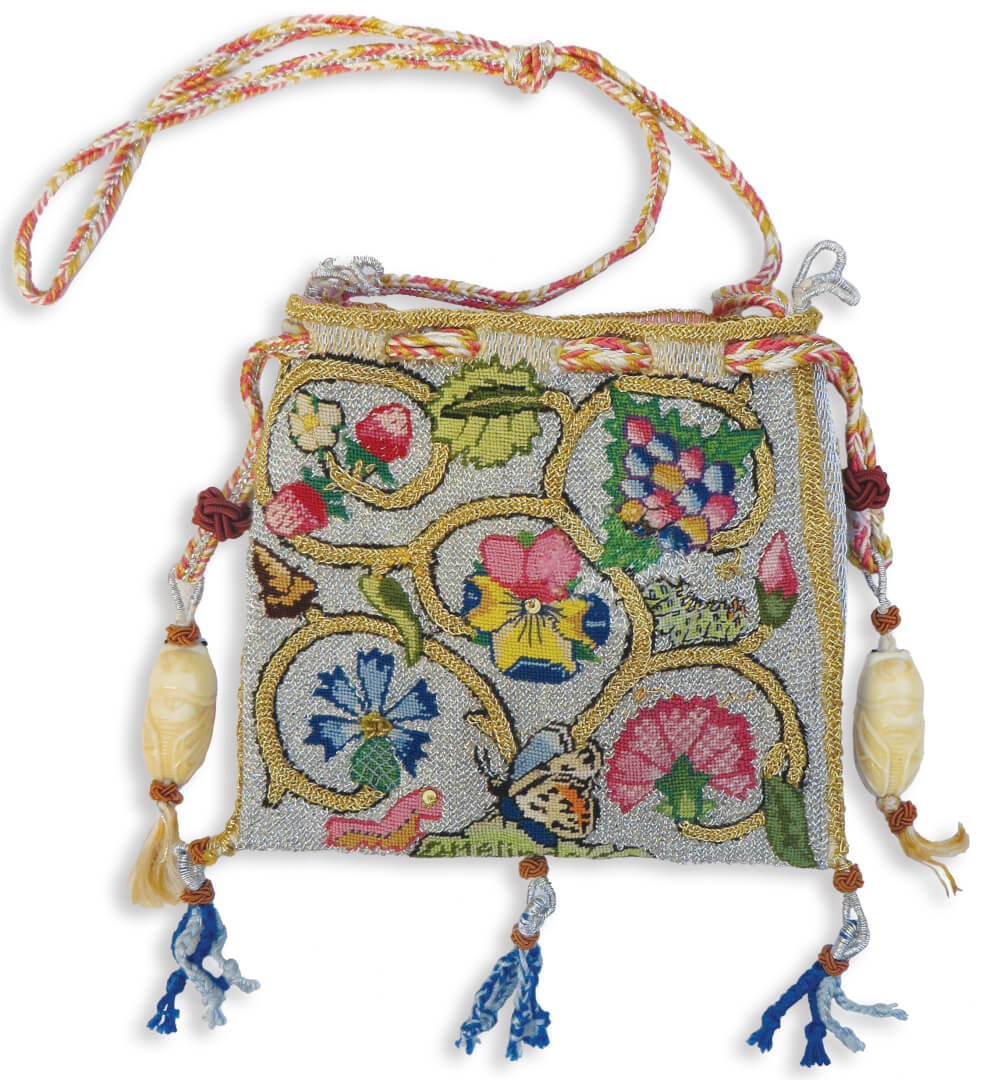
Sweet Bag Sewed of Silver and Gold
On our Group Correspondence Course Sweet Bag Sewed of Silver and Gold stitch an embroidered bag like the ones that were in style in England from the mid-1500s to the mid-1600s.
Recently Sherbring designed Elizabethan Enchantment: An Introduction to Late Sixteenth-Century Embroidery. It looks quite different from her other Elizabethan designs because she added New Mexican motifs to honor her home state, the Land of Enchantment. She added Native American squash blossoms; the state bird, the roadrunner; a whiptail lizard; and lines of spiny cacti. Elizabethan flora such as pomegranates and irises, symbolic of Spain and France, respectively, also represent how our nation grew, given Spain’s colonization of Florida and Texas and securing the Louisiana Purchase from France. She used many Elizabethan stitches including Ceylon; plaited braid; detached buttonhole; lark’s head filling; spiderweb; French knot; chain, satin, and stem stitch; and squiggle stitch, which she found on a coif in the Burrell collection.
Since Sherbring retired from her day job in 2013, she has enjoyed teaching embroidery and sharing the interesting things she has found lurking in historical pieces. She is working to submit a new Group Correspondence Course, Hearts Ease, a course in beginning blackwork.
